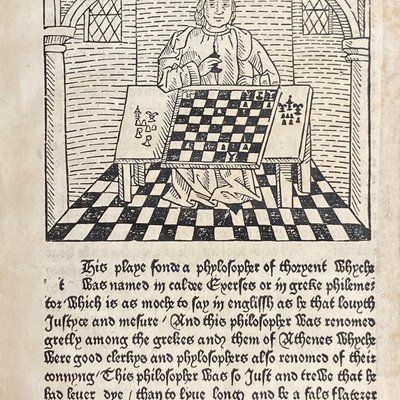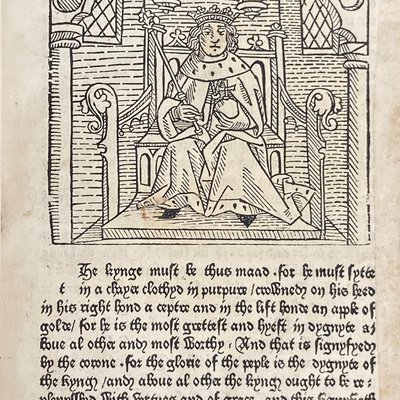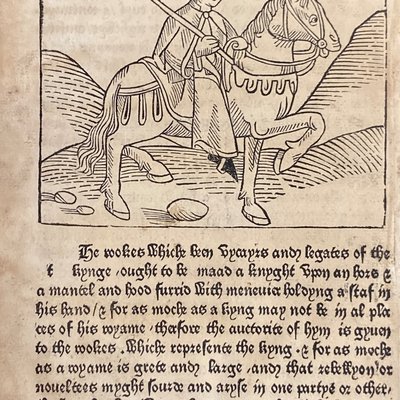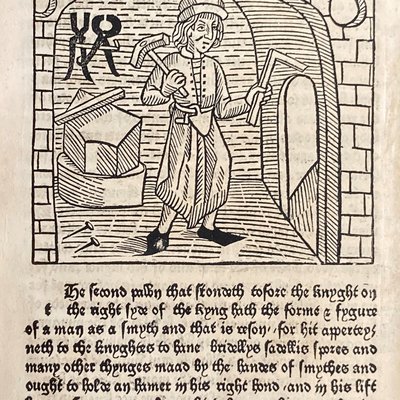September 2022
In September, the days are getting shorter again and thoughts are gradually returning to in-house pursuits. There is no better time to dust off the old chess set.
Almost from the beginning chess was perceived as a metaphor for human life, first for war in particular and then for society as a whole (Antin 1968, p. 272). In Europe the best-known chess metaphor was put forward in the 13th-century by the Italian Dominican Jacobus de Cessolis (c1250-c1322) in his Liber de moribus hominum et officiis nobelium super ludo scacchorum. The text is divided into four sections (Antin 1968, pp. 270-1):
- A fanciful account of the invention of the game (its origin myth, as it were)
- Descriptions of the noble chess pieces and their roles in life (one chapter for each chess piece)
- Descriptions of the pawns, which are represented as different groups of commoners (one chapter for each type of pawn)
- Description of the chessboard followed by the moves of the pieces and their significance.
Instead of presenting instructions for how to play the game, Cessolis’s work consists of sermons using chess as a moralising allegory to society. As Jenny Adams has shown, Cessolis described ‘a society of reciprocal, contractual relations dependent on individual autonomy at the same time that it maintains a clear sense of hierarchy’ (2004, p. 155).
The English merchant-turned-book printer William Caxton (c1415-1492) translated Cessolis’s text into English from earlier French translations. He published the first edition of The Game and Play of Chess as his second ever publication while still on the continent in 1475. Caxton is believed to have returned to England in 1476, setting up the first printing press in England in Westminster. In 1483 he published a second edition of The Game and Play of Chess, of which St John’s College holds a copy. Caxton made two significant changes for the new edition: firstly, he added woodcut illustrations and, secondly, he replaced the royal dedication (and the extended epilogue) with a new preface.
Twenty-four woodcuts were positioned one each at the head of every chapter. The first woodcuts illustrate the origin myth of chess: the brutal killing and dismemberment of King Nebuchadnezzar by his son Evilmerodach and the invention of chess by the philosopher Philometer as a means of instructing Evilmerodach in ‘humane governance’ and ‘how to live a virtuous life’ (Adams 2004, p. 153). The woodcuts in the second and third sections illustrate the individual chess pieces as described at the start of each chapter. The final woodcut shows Philometer with his chessboard again. According to Louise Fang, the illustrations strengthen and reinforce the socio-political allegory of chess because the pieces are represented as humans rather than inanimate objects: ‘It is as though the chess pieces on the chessboard shown in the second woodblock illustration came to life” (2020, p. 294). Although many medieval manuscripts of Cessolis’s text are accompanied by illustrations, this ‘humanization of the chess pieces’ is unique to Caxton’s second edition (Fang 2020, p. 295).
By replacing the royal dedication and the epilogue with a new preface, Caxton dramatically changed the tone of his publication. His first edition had emphasised the role of the king (and aristocracy), giving it almost the guise of a ‘mirror for princes’ (Adams 2004, p. 157). By contrast, the second edition became more inclusive. In line with Cessolis’s original work, Caxton now emphasised that everyone should take this book as an example to amend their ways (Adams 2004, p. 159).
William Caxton may have changed the tone of the second edition because he was now targeting a different audience. While the first edition appears to have been produced with the royal court as a potential audience, the second edition may have been aimed at a merchant audience. According to Fang (2020, p. 297), this may also explain the ‘humanization’ of the chess pieces in the woodcut illustrations. Only the aristocracy was able to afford chess sets with luxurious, detailed pieces that matched their description in Cessolis’s text. Even rich commoners like merchants were more likely possess crudely cut chess pieces and so Caxton’s illustrations may have enabled them to take part in the ‘lively and sophisticated visual culture’ of chess previously reserved for royalty and the aristocracy (2020, p. 291).
St John’s copy of Caxton’s second edition of The Game and Play of Chess arrived as part of a bequest from the physician and St John’s fellow Nathaniel Crynes (1685/6-1745), who was an avid book collector.
Interested in other Caxton publications? There is a brief blog post about St John’s copy of Caxton’s second edition of Chaucer’s Canterbury Tales at https://stjohnscollegelibraryoxford.org/2014/07/30/geoffrey-chaucer-the-canterbury-tales-westminster-william-caxton-c-1483/
References:
Adams, Jenny (2004) ‘“Longene to the playe”: Caxton, Chess, and the Boundaries of Political Order’, Essays in Medieval Studies, 21, pp. 151-166.
Antin, David (1968) ‘Caxton’s The Game and Play of the Chesse’, Journal of the History of Ideas, 29, pp. 269-278
Fang, Louise (2020) ‘The Printed Book and the Visual Culture of chess in the Late Middle Ages: William Caxton’s 1483 Edition of The Game and Playe of Chess’, in Kopp, Vanina and Lapina, Elizabeth (eds) Games and Visual Culture in the Middle Ages and the Renaissance. Studies in the History of Daily Life, 8. Turnhout: Brepols, pp. 289-298.










